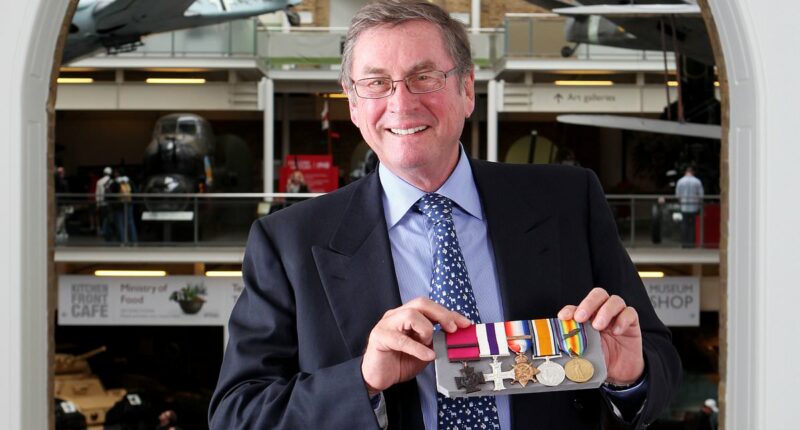Share this @internewscast.com
Tuesday is going to be a difficult occasion for me – one of the saddest in my near 80 years on this planet.
Today marks the day when the Imperial War Museum has decided, in its wisdom, to close the gallery that bears my name, which houses the world’s largest collection of Victoria Crosses.
It has taken me almost 40 years, half of my life, to build this collection of well over 200 VCs and a smaller collection of George Crosses.
The decorations, which represent the two highest gallantry awards that Britain and the Commonwealth can bestow, have been exhibited at the IWM’s Lord Ashcroft Gallery for the past 15 years.
Now, the museum intends to utilize the space to showcase more of its 33 million items, focusing on displays related to more recent conflicts—likely aligning with its goal of ’embedding diversity’ into its exhibitions.
Little wonder that critics of the decision now dub the institution the ‘Imperial Woke Museum’.
Since the IWM revealed its plans in February, I have received numerous messages of support stating that the decision is plainly wrong. Many have argued that closing the gallery is an insult to both living and deceased recipients of the VC and GC, as their medal collections will now be stored securely away, out of the public’s view.

Lord Michael Ashcroft at the Imperial War Museum with medals belonging to Captain Noel Chavasse, one of only three men to be awarded the VC twice, known as a VC and Bar.
The VC is Britain and the Commonwealth’s premier medal for gallantry in the presence of the enemy.
The GC represents Britain and the Commonwealth’s highest medal for bravery not in the face of the enemy. Each award is accompanied by an extraordinary story of courage, and these inspiring tales have captivated tens of thousands of visitors to the gallery since its official opening by HRH The Princess Royal in 2010.
As of this Tuesday, visitors to the IWM in south London will no longer be able to learn about the heroic Second World War exploits of Sergeant Norman Jackson when his Lancaster aircraft was hit by enemy fire during a bombing raid over Germany in April 1944.
With a fierce blaze near a fuel tank on the upper surface of the starboard wing, Jackson, though already wounded by shrapnel from the enemy shells, volunteered to climb out of the escape hatch above the pilot’s head, having placed a fire extinguisher in the top of his life jacket in order to try to put out the blaze.
As he climbed out, his parachute pack opened and the canopy and rigging lines spilled into the cockpit.
With the Lancaster travelling at 200mph at 20,000ft, other crew members fed out the rigging lines of his parachute as he climbed on to the fuselage and set about tackling the blaze. However, the fire extinguisher slipped from his grasp and was blown away.

Chavasse was first awarded the VC for his actions in August 1916 at Guillemont, France, when he attended to the wounded all day under heavy fire
Jackson himself fared little better and his face, hands and clothing were severely burnt. Unable to retain his hold, he was swept through the flames and over the trailing edge of the wing, dragging his parachute behind.
When last seen, his parachute was only partly inflated and burning in places. At this point, the captain ordered the remaining crew to abandon the aircraft.
Jackson could not control his descent and broke an ankle landing heavily. At daybreak and by this point in a pitiful state, he crawled to the nearest village where he was soon taken as a prisoner of war. He spent the next ten months in hospital before being incarcerated and he was eventually released at the end of the war.
The citation for Jackson’s VC, announced shortly after his release, concluded: ‘By his ready willingness to face these dangers he set an example of self–sacrifice which will ever be remembered.’
As of this Tuesday, visitors to the IWM will also no longer be able to learn about the courage of Captain Noel Chavasse during the First World War.
A one–time Olympic athlete who was a regimental medical officer on the Western Front, Chavasse’s place in the history books is guaranteed because he is one of only three men in the entire history of the VC to be awarded the decoration twice – known as a VC and Bar.
One of identical twin boys and an Oxford graduate, he was an officer in the Royal Army Medical Corps and his devotion to duty defied belief. Chavasse was first awarded the VC for his actions in August 1916 at Guillemont, France, when he attended to the wounded all day under heavy fire.
During the ensuing night, he searched for wounded on the ground in front of the enemy’s lines for four hours. Altogether, he saved the lives of some 20 badly wounded men.

Visitors to the IWM will no longer be able to learn about the heroic Second World War exploits of Sergeant Norman Jackson when his Lancaster aircraft was hit by enemy fire during a bombing raid over Germany in 1944 (pictured with his wife at Buckingham Palace to receive his Victoria Cross)

Sergeant Jackson’s Victoria Cross. His citation read: ‘By his ready willingness to face these dangers he set an example of self–sacrifice which will ever be remembered’
His second VC, the Bar, was awarded for three days of relentless gallantry during the third Battle of Ypres in Belgium – also known as the Battle of Passchendaele – during late July and early August 1917. Although badly wounded himself, he spent day and night under fire rescuing badly injured men.
Chavasse died in a medical dressing station from his wounds that August, aged 32, and so the Bar to his first VC was awarded posthumously.
These are just two of the many astonishing stories that are linked to my VC and GC collection. I like to regard the recipients of these two medals as ‘the bravest of the brave’ because they have all risked their lives for their country, their monarch, their comrades or for wider freedoms.
I feel deeply moved when I learn of the self–sacrifice of Jackson, Chavasse and others like them. Their medal groups and the memorabilia that often accompanies them are a tangible memento of an individual’s service and bravery.
My own interest in valour dates back some 70 years. When I was aged about ten, my father Eric, who was a modest man, told me about his own experiences as a young officer during the D–Day landings of June 6 1944. He described crossing the English Channel in a state of fear and
then running up Sword Beach during the early stages of the Normandy Campaign, when his commanding officer was shot dead at his side. Later that morning, my father was wounded by shrapnel but fought on until ordered from the battlefield.

My VC and GC collection is valued at around £70million and I had made arrangements to gift it to the IWM when I die. All that changed earlier this year when I discovered that the IWM had decided to close the Lord Ashcroft Gallery
Over time, my passion for bravery transformed itself into a fascination with gallantry medals, those dating back to the institution of the VC by Queen Victoria in 1856.
As a young entrepreneur, I decided that one day, if my finances permitted, I would like to buy a VC.
In fact, I purchased my first such decoration at an auction in London in 1986 when I was 40. I soon decided that I would like to build a collection of VCs and that, when the time was right, I would put it on public display so that the decorations could be enjoyed by visitors from all around the world.
Over time this collection, built up sensitively and discreetly, amassed gallantry medals from virtually every major conflict of the past 170 years.
As my collection grew, I felt that it was important to display the decorations at a truly special location. After lengthy discussions, I settled on the Imperial War Museum in London which, according to its website, ‘gives voice to the extraordinary experiences of ordinary people forced to live in a world torn apart by conflict’.
However, when I initially offered to loan the decorations to the IWM, it insisted that I must pay for the gallery housing my VC and GC collection, along with a smaller number of VCs and GCs that were already in the care of the museum.
I went along with those wishes, spending £5 million to create the Lord Ashcroft Gallery, with its ‘Extraordinary Heroes’ exhibition, which seeks to ‘intrigue, inspire and amaze by re–telling forgotten stories of great bravery from the Crimean War to the present day’.

It is more than a little galling that although the IWM no longer wants my medal collection, it will keep the gallery that I paid for to house its other exhibitions (pictured, Lord Ashcroft Gallery)
It is more than a little galling that although the IWM no longer wants my medal collection, it will keep the gallery that I paid for to house its other exhibitions.
My VC and GC collection is valued at around £70million and I had made arrangements to gift it to the IWM when I die. All that changed earlier this year when I discovered, through an intermediary, that the IWM had decided to close the Lord Ashcroft Gallery.
Initially, it was due to shut down at the end of May but I ‘persuaded’ the IWM, by threatening legal action, to keep the gallery open for the full term of the loan agreement – until the end of September.
Incidentally, a friend of mine paid a last visit to the gallery earlier this month and said it had 30 to 40 visitors at any one time while he was there. When he popped into the ‘Unsilenced: Sexual Violence In Conflict’ exhibition, there was just one person, a student.
Some fear the gallery will become even more woke following the appointment of three more trustees by the Prime Minister, Sir Keir Starmer, earlier this year. None of these trustees, whose four–year term will run until 2029, has a military background.
One of the trustees, Professor Dame Janet Beer, an academic, was awarded her damehood ‘for services to higher education and equality and diversity’.
As a museum dedicated to military history, I appreciate that the IWM has to examine other aspects to war and conflict apart from bravery. Some people are interested by military equipment, military tactics, the analysis of battles and much more, but I would argue that nothing inspires a museum audience of this nature as much as tales of gallantry.
As Aristotle put it as long ago as the 4th century BC: ‘Courage is the first of human qualities because it’s the quality which guarantees the others.’
Or, as our great wartime prime minister, Winston Churchill, stated: ‘Without courage all other virtues lose their meaning.’
Every man or woman desires to be looked upon by his or her peers as brave because those who display bravery are, quite rightly, admired by society. Courage is a truly outstanding quality, yet it is so difficult to understand. You can’t accurately measure it, and you certainly can’t bottle or buy it.
I fear for the future of the IWM if it starts to downplay the value of courage and gallantry medals and instead starts to embrace woke issues in its stated desire ‘to share more stories of conflicts that are within many of our visitors’ living memory’.
The IWM has not gone so far as to ‘cancel’ the First and Second World Wars, or earlier wars, but the shift in its priorities rings loud and clear.
Frankly, if it is now considered old–fashioned to want to champion the qualities of courage along with the values of duty, loyalty, sacrifice and humility, then I am more than happy to be regarded as out of touch with the times.
However, I suspect that in the long run, the ‘woke–ification’ of the IWM will run its course and one day it will bow to a public clamour for this once–great institution to go back to doing what it has done best for more than a century: being the world’s leading museum on war and conflict.
Part of that role – a very major part in my view – involves highlighting the gallantry of servicemen and women in war.
In time, I will find a suitable alternative venue for the VC and GC collection that I am the proud custodian of but, as of this week, it will disappear from public view for the foreseeable future.
My stream of messages from so many people in recent months makes me convinced that our nation, and not just the IWM, will be a poorer place without it.
- Lord Ashcroft KCMG PC is an international businessman, philanthropist, author and pollster. For more information on his work, visit lordashcroft.com. Follow him on X/Facebook @LordAshcroft.





